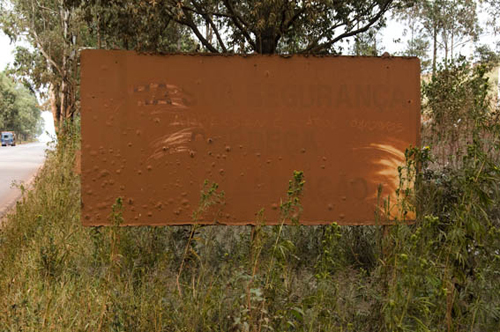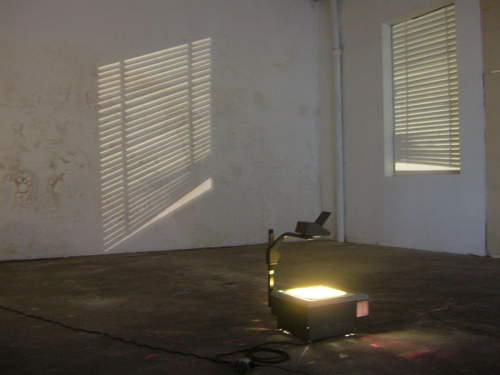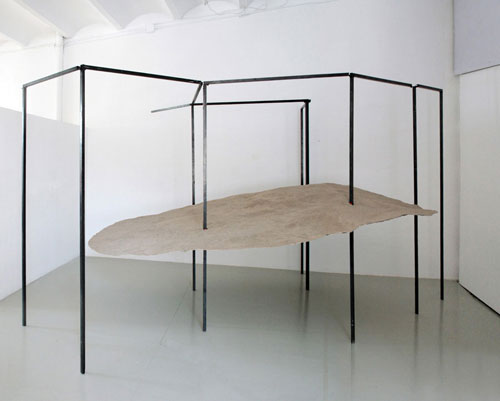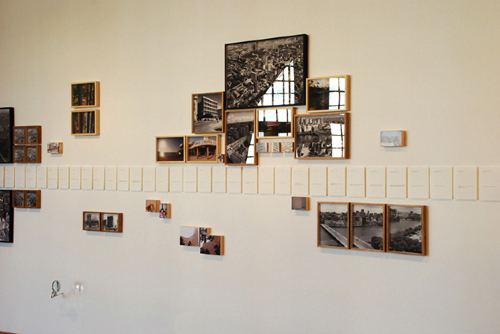
Cao Guimarães and Carolina Cordeiro. “Campo Cego (Blind Field) #2,” 2008. C-print. Courtesy Galeria Nara Roesler.
This is Part II of my conversation with Tumelo Mosaka; part 1 posted on the Art21 Blog last Friday. Mosaka is discussing his upcoming co-curatorial project (with Irene V. Small) “Blind Field,” which focuses on twenty Brazilian artists. “Blind Field” will be presented at the Krannert Museum and later, the Broad Museum (June 13).
GK: Let’s talk “Blind Field,” your forthcoming project with Irene V. Small featuring twenty Brazilian artists at the Krannert Museum, which will also be shown at the Broad Museum in June 2013. Tell me about the selection process of the artists, the studio visits, and about the time you spent in Brazil last March.
TM: I’ve been visiting Brazil over the past 6 years and have gotten familiar with the art world. So when the opportunity appeared at the University of Illinois with the establishment of the Lehmann Institute (a Brazilian Studies Center at the University of Illinois), I thought this opportunity would expand the dialogue from commerce to culture, considering the expansion of Brazil’s economy. I’ve developed this project together with Irene Small who has vast knowledge of art in Brazil. Our approach was to first look at artists’ works we were familiar with and then, looked at several exhibitions and catalogues of major shows over the last five years in Brazil. From this experience, we came up with a long list of artists who we thought were of interest. Then there was the challenge of setting up studio visits, and since most artists are based in Sao Paulo, Rio de Janerio, Belo Horizonte, Recife and Goiania, it was difficult to cover such a wide territory as our funds were limited.
Overall we managed to visit at least 90% of the artists in the show. Its not always the best scenario but time and money are always a challenge when working on such large projects. We spent about three weeks looking at works and discussing with artists. For the most part, artists loved discussing their works with us and also recommended others to see. It’s great when that happens but there is never enough time. Once back, we were able to think about the experience and to notice some common threads particularly related to the idea of transitions. Hence the titled “Blind Field,” which is a metaphor for the way in which the obstruction of perception illuminates alternative modes of knowledge and experience. This allowed us to revisit the works and see how these artists were thinking about notions of opacity and transparency of knowledge.
GK: As you discuss in your notes “the country of the future” (o país do futuro), a Brazilian saying, you write […] “Brazil is the country of the future, and will always be,” suggesting that the idea of potentiality is itself something of a mirage, an illusion that blinds its citizens to the reality of the present day. It almost sounds frightening. What are some of the “blind fields” the selected artists bring to light?
TM: We use Blind Field as a metaphor for the ways obstruction of perception can illuminate alternative modes of knowledge. Henre Lefebrve writes that blinding is the light that illuminates elsewhere as well as leaves certain areas in the shadow blinded by the beam of light. So the works selected focus on making transitions perceptible.
Take Cao Guimarães and Carolina Cordeiro’s work Campo Cego (Blind Field) from 2008; photographs depict images of road signs concealed by layers of accumulated dust. Designed to direct and control, the signs have been rendered indecipherable and abstract over time. While their given message is obscured, the blankness of the resulting monochromes seems to suggest an alternate communicative potential stemming from the conflation of the natural and artificial. The “blind field” here is both a literal surface and a conceptual and critical possibility. It disrupts the habitual transfer of information and asks us to imagine alternate ways of negotiating and marking a given environment.
Nicolas Robbio is interested in liberating materials and objects from their use-value and thereby highlights certain qualities and relationships that we normally are unaware of. In Untitled 2008, he uses obsolete overhead projectors placed on the floor to project images of window blinds, which marks a separation of interior and exterior spaces. The blinds perform a double function; first, they are intended to obstruct the light that comes in from the exterior as well as the image from the outside. This work is produced by way of the projectors, which, in an inverse fashion, function by emitting light from the interior of the devices to the exterior space in which they are placed.

Nicolás Robbio. Sem titulo (Untitled), 2008. Cut paper and projector. Courtesy Galeria Vermelho, Sao Paulo.
For Robbio, real space as such is rendered illegible, and it is the illusion that allows the viewer to rediscover new potential in what is hidden in plain sight.
Such questions of perception and illusion are taken up further by Daniel Steegmann Mangrane through the lens of the economy. While Europe and the United States are witnessing recessions, Brazil’s recent economic expansion has turned the country into a global player. Steegmann’s Duna económica/ Maqueta sin Calidad (Economic Dune/Model without quality) 2011, takes the dune as a metaphor for the unpredictable change and fragility of global markets, whose individual financial systems can never be secured. The dune is both a formidable force that changes rapidly as a result of winds, and a physical entity that creates a shelter and barrier from these same winds. Its dual function as a transformative and destructive agent is analogous to the unpredictable behavior of markets, which likewise have the capacity to produce massive change as a result of imperceptible shifts.

Daniel Steegmann Mangrané, “Economic Dune/Model without quality,” 2011. Steel modular structure, fiberglass, sand. Courtesy of the artist.
Lastly, Jonathas de Andrade excavates memories embedded within the urban context. His approach concerns how history is produced through intimate as well as institutional archives. Tropical Hangover is structured around a found diary that provides an anonymous account of life in the city of Recife in the 1970s. These discarded pages are combined with documentary photographs of the city’s development from its high modernist period to its present decline along with photographs from various personal archives. These images and text together construct a narrative that is part-fact, part-fiction–whose multiple dimensions of memory both cancel one another out and produce a possible document of urban reality. By conflating past with present, public with private, de Andrade depicts Recife’s urban history as a zone of transition and, in this sense, a “blind field” of experience that becomes legible in the present.

Jonathas de Andrade. “Ressaca Tropical (Tropical Hangover),” 2009. 105 photographs and 140 typewritten pages. Private Collection, Lima, Peru. Courtesy Galeria Vermelho, Sao Paulo.
As you can probably tell, these artists work in a wide range of media. They offer a critical perspective on processes of transition within contemporary society. While much of the work gestures implicitly or explicitly to issues current within Brazil, none subscribe to the idea of a monolithic Brazilian identity or artistic sensibility. By including not only Brazilian artists, but artists from abroad who are working in Brazil, the exhibition also resists the impulse to define a national identity through art. Instead, the works speak to the complexity and heterogeneity of an art milieu that is manifestly global in reach.
GK: What is that show at the back of your head, waiting to be realized?
TM: Well, I’ve done a number of group exhibitions and artist’s projects so far which have been very rewarding. What I haven’t really done is a monograph. The intensity of focusing on a body of work by a single artist is very different to working on artists’ projects. I think this is another direction I would like to pursue and I’m interested in artists like David Hammons and Senegalese artist Ousmane Sembene. Both very different in their approach to art making and extremely extraordinary in their creativity. Whether this will happen, we’ll have to wait and see. The road is long, time is short and money scarce, so the future remains unpredictable.
And, that’s a wrap!



